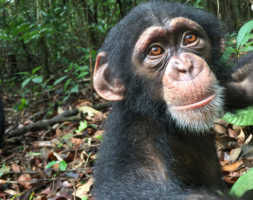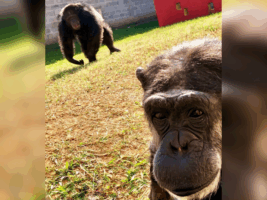The drama of African sanctuaries

PASA IN NUMBERS
The creation of African sanctuaries is not long past – less than 20 years – and their numbers increased with the creation of PASA – Pan African Sanctuaries Alliance, which coordinates them for a little bit more than 10 years. In 20 sanctuaries affiliated to the alliance, more than one thousand great apes, mainly chimpanzees, receive shelter, despite the difficulties faced to develop the work in some of the African countries, which are politically messed and face urgent human problems to be solved.
A work published at Primatology International Journal this months, produced by a group of researchers – including Doug Cress, executive director of PASA – directed by L. J. Faust, from Population Biology Center, from Chicago, tries to establish the needs of sheltering at African sanctuaries demanded for the next 20 years, considering today rhythm of arrival of more than 60 orphan chimpanzees per year at these sanctuaries.
The population of chimpanzees in African sanctuaries is different from the majority of the sanctuaries outside Africa, as long as it is mostly consisted by less than three years old orphan babies. This is the result of illegal hunting of adult great apes, who are killed for the selling of their flush and the babies are kept alive to be sold as pets. Those who are confiscated by local authorities (a small amount of the total that are traded and a lot of them even end up dying due to the lack of proper care) are sent to sanctuaries.
Considering the fact that a chimpanzee in captivity in a sanctuary can live for more than 50 years, the pressure faced by these sanctuaries when they received the babies is to ensure the financial conditions to keep them alive for this long existence.
In non-African sanctuaries it is rare the arrival of babies. The most common is to receive middle age primates, around 15 and 20 years old, who suffer from deep mental problems. This makes it more difficult to form big groups, which could facilitate the management and the reduction of costs in any sanctuary. As long as the population is young in Africa, it is possible to get them used to live in big groups, reducing the costs of constructions and attendance.
The majority of the sanctuaries in the world is supported by private organizations, which collect funds in the society to keep the work. The lack of an effective politics for the return of chimpanzees to their natural habitat in the last 10 years – around 50 were reintroduced and there are no safe area to send them – reinforces the need to strength the work especially at African sanctuaries, which need substantial fund donations, private or public, to be able to keep and maintain the new guests (growing in a rhythm of 10% per year).
Source (PDF file): Predicting Capacity Demand on Sanctuaries for African Chimpanzees, Lisa J. Faust, Doug Cress, Kay H. Farmer, Stephen R. Ross – Benjamin B. Beck
Dr. Pedro A. Ynterian
President, GAP Project International

 Español
Español
 Português
Português








